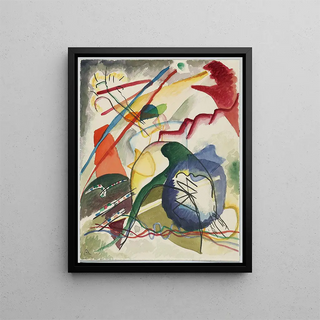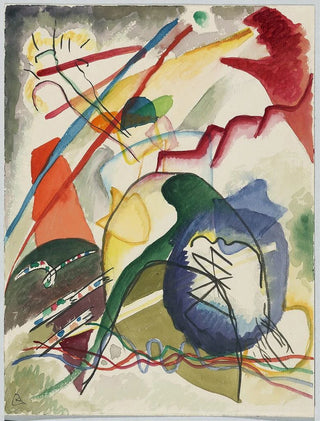Art print | Image project with a white border I - Wassily Kandinsky


View from behind

Frame (optional)
Wassily Kandinsky’s artwork "Image Project with a White Border I" presents an invitation to immerse oneself in the vibrant, colorful universe of abstract art. Celebrated for its ability to transcend mere representation, this piece embodies the very essence of creativity and imagination. Observing this composition, the viewer is transported to a world where shapes and colors dialogue freely, creating an atmosphere that is both dynamic and contemplative. Kandinsky’s choice to play with the white border framing his work suggests a separation between reality and imagination, inviting exploration of the depths of the human mind.
Style and uniqueness of the artwork
Kandinsky’s style is unmistakable, characterized by geometric shapes and vivid colors that blend harmoniously. In "Image Project with a White Border I," the artist demonstrates mastery of contrasts and visual rhythms. The flowing lines and bursts of color evoke a visual symphony, where each element finds its place within a subtle balance. The use of the white border is not merely a frame; it acts as a breathing space, allowing the artwork to express itself fully while creating tension between the interior and exterior. This innovative approach reflects Kandinsky’s desire to free art from traditional constraints, aiming to evoke emotions and sensations in the viewer.
The artist and his influence
Wassily Kandinsky, an iconic figure of the abstract movement, left a significant mark on his era with his bold vision of art. Influenced by currents such as Fauvism and Cubism, he developed a unique artistic language based on the expression of emotions rather than faithful representation of the world. His theory of color and forms profoundly influenced many contemporary artists and paved the way for new explorations in the field of art. Kandinsky firmly believed that art should touch the soul, and his work "Image Project with a White Border I" is a perfect illustration of this. Striving to establish a spiritual connection between the artwork and the viewer,

Matte finish

View from behind

Frame (optional)
Wassily Kandinsky’s artwork "Image Project with a White Border I" presents an invitation to immerse oneself in the vibrant, colorful universe of abstract art. Celebrated for its ability to transcend mere representation, this piece embodies the very essence of creativity and imagination. Observing this composition, the viewer is transported to a world where shapes and colors dialogue freely, creating an atmosphere that is both dynamic and contemplative. Kandinsky’s choice to play with the white border framing his work suggests a separation between reality and imagination, inviting exploration of the depths of the human mind.
Style and uniqueness of the artwork
Kandinsky’s style is unmistakable, characterized by geometric shapes and vivid colors that blend harmoniously. In "Image Project with a White Border I," the artist demonstrates mastery of contrasts and visual rhythms. The flowing lines and bursts of color evoke a visual symphony, where each element finds its place within a subtle balance. The use of the white border is not merely a frame; it acts as a breathing space, allowing the artwork to express itself fully while creating tension between the interior and exterior. This innovative approach reflects Kandinsky’s desire to free art from traditional constraints, aiming to evoke emotions and sensations in the viewer.
The artist and his influence
Wassily Kandinsky, an iconic figure of the abstract movement, left a significant mark on his era with his bold vision of art. Influenced by currents such as Fauvism and Cubism, he developed a unique artistic language based on the expression of emotions rather than faithful representation of the world. His theory of color and forms profoundly influenced many contemporary artists and paved the way for new explorations in the field of art. Kandinsky firmly believed that art should touch the soul, and his work "Image Project with a White Border I" is a perfect illustration of this. Striving to establish a spiritual connection between the artwork and the viewer,






